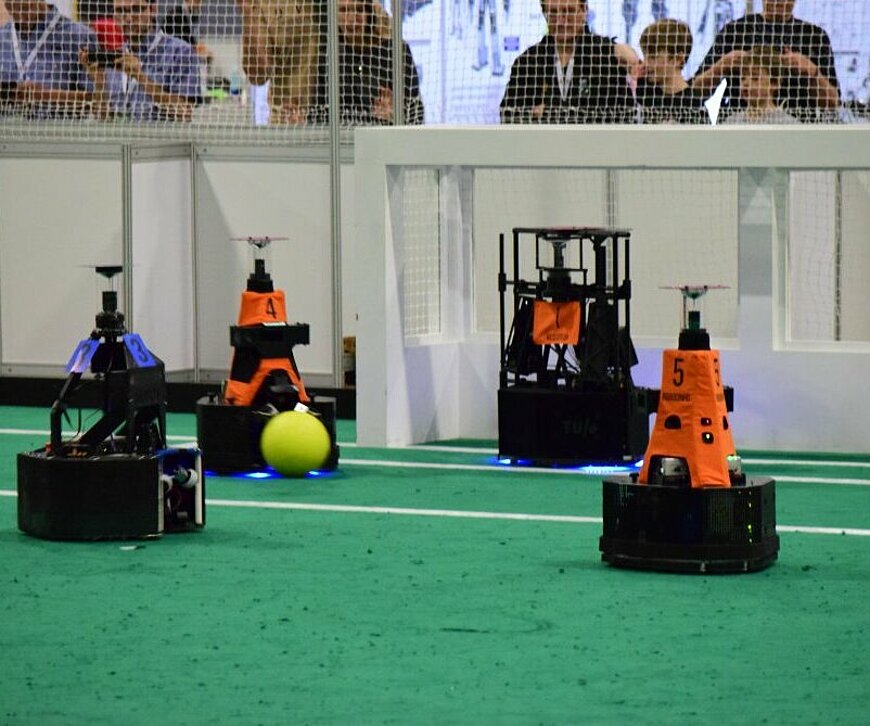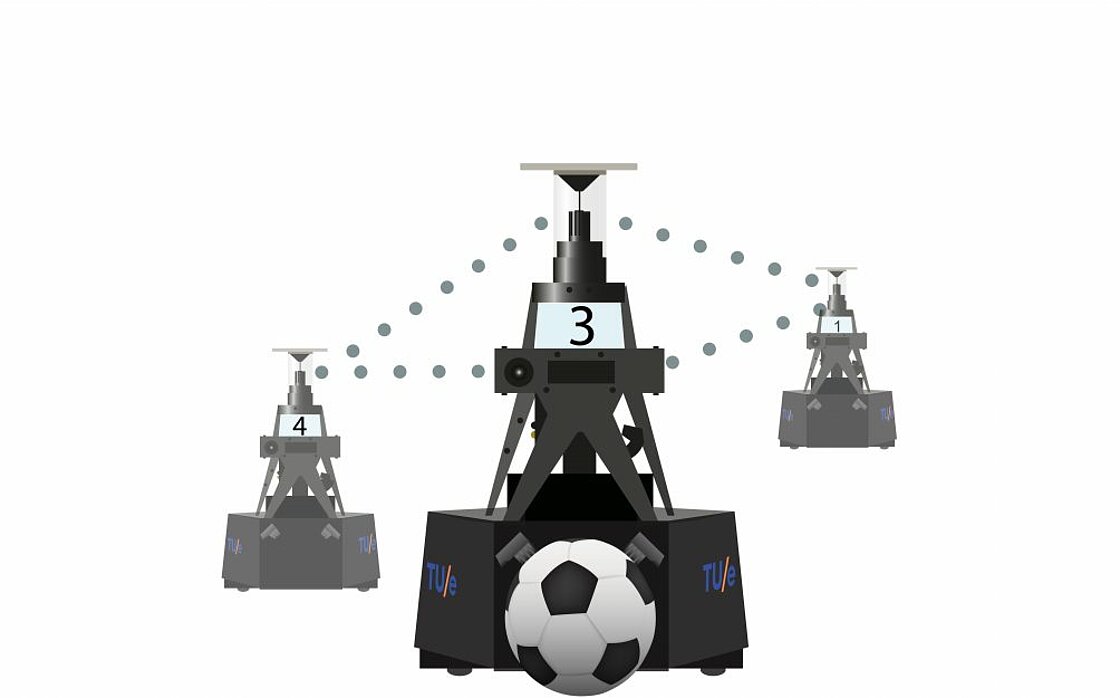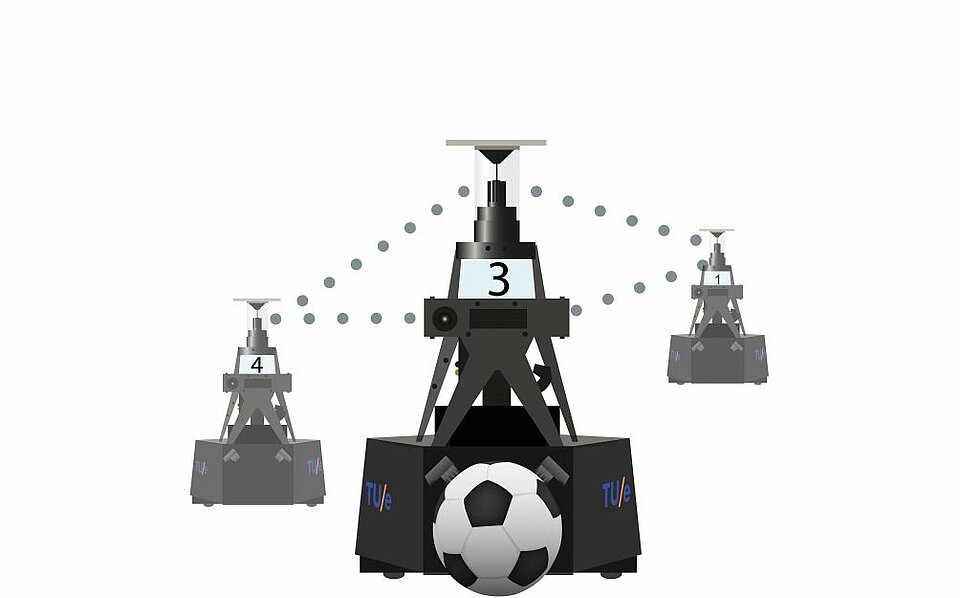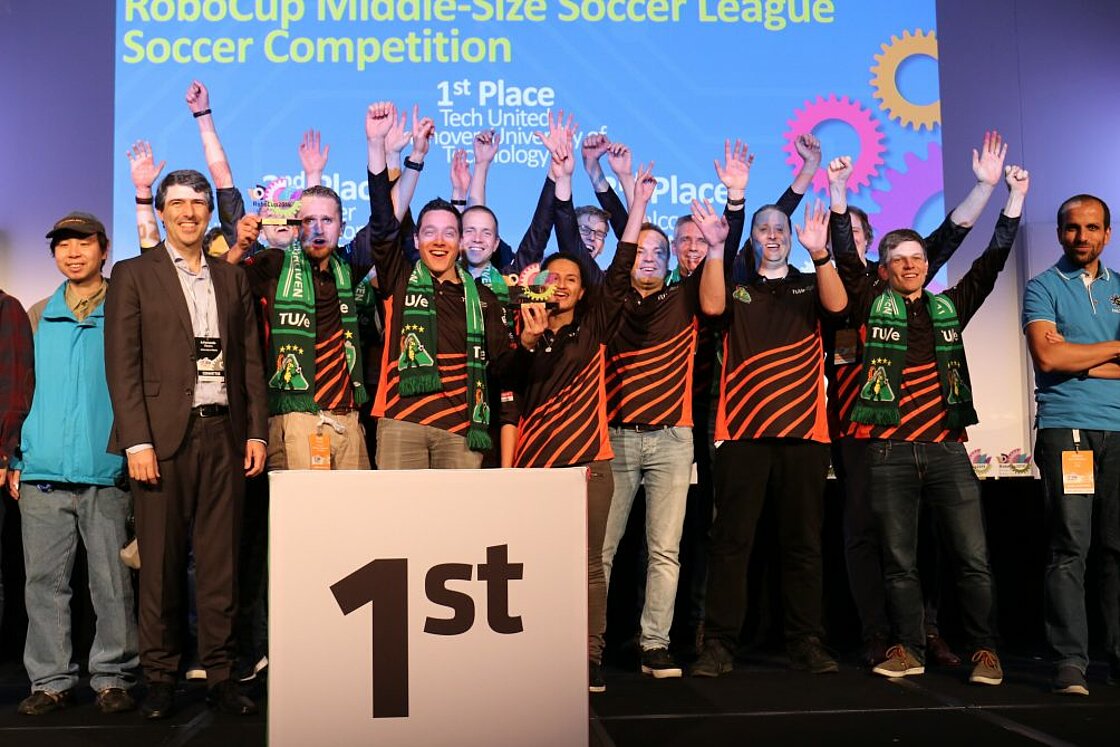‘Soccer robots must defeat human world champions by 2050’

Going to a good game at the stadium or watching a match in front of the telly. The women and men from the Dutch national football teams have wee nieces and nephews: Soccer robots.
The motorized versions of the Orange Lionesses (the Dutch women’s football team), as in Jackie Groenestroom, Lieke Motors, and Vivianne Wielema, have already taken home the Robo Cup (the Robot Soccer World Cup) five times already. University senior lecturer René van de Molengraft and team leader of Tech United Ainse Kokkelmans are expecting soccer robots to become increasingly popular. “I think in ten years’ time, we will be buying a ticket to watch robot soccer matches,” says Van de Molengraft.
The senior lecturer of Motion Control Technology at the TU/e Department of Mechanical Engineering was at the birth of the robot soccer team fifteen years ago. Since then, the Eindhoven soccer robots have become a household name at the RoboCup. That’s the annual, international competition where soccer robots from all over the world play against each other.
Kokkelmans has been the team leader of Tech United for over a year now. What is the most remarkable thing about soccer robots? “After each RoboCup, all the participating teams get to share their knowledge with each other so that we can continue to innovate together. The technologies that have been developed can subsequently be used in other areas as well,” she explains. For example, in the development of service robots or autonomous cars.


Worldview
The robot soccer team has improved steadily more over the past few years. The cone-shaped robots stand on three wheels allowing them to drive in all directions at all times. On top of the robot is a camera that can look at its surroundings through a spherical mirror. This enables it to recognize the lines on the field, the opponents, the teammates, and the ball. The robot can measure depth using a camera at the front of the robot. It uses an electromagnet to kick the ball. The robot has an onboard computer to control all of these components. “The robot creates a worldview from all the data it collects,” Kokkelmans explains. “All the robots in the team share this with each other so that they can work together in an optimal way.”
Determining strategy
Aside from all this, the robots communicate with each other and the referee about what’s going on in the game. For instance, the referee transmits signals during a free kick. “In addition to the computer, a human referee is standing along the lines to check if the robots stick to the rules,” says the team leader. “If the robots commit a foul, they receive a yellow or red card. This meant that we had to play the last World Cup with one less robot on the pitch.”
Based on the rules, the players also have to determine a strategy. Artificial intelligence is used for this. “The robots recognize a particular game scenario and determine a strategy based on that,” she continues. “We want the robots on the field to be able to learn from the opponent and adjust their strategy accordingly.”
The robots have to be able to reason on their own what the best strategy is at any given moment. Van de Molengraft: “The robots consider an attack formation and communicate with each other to do it. The situation on the pitch is changing very fast, the robots ‘run’ about four meters per second.
Optimization
Tech United optimizes the robots by awarding points for a specific situation. “Suppose that a robot wants to pass on the ball, then you want the ball to go through open space. If the line that the ball is going to follow is close to the opponent, then that isn’t a good position to make a pass. So, that won’t earn very many points. If the ball passes through an open area on the pitch, then that’s a good position and moment to make a pass. They score more points that way,” Van de Molengraft goes on to explain. “This is how the players learn to make increasingly better decisions. The robots also communicate these plans with each other so that they really work together as a team.”
All dynamic environments
The algorithms that the soccer robots use for their game can also be used for other applications. Kokkelmans: “In the past, robots were mainly used in controlled environments such as factories. Nowadays, robots are increasingly living in a dynamic world where people move around.”
These are, for example, service robots that work in a hospital. Or autonomous cars that travel on public roads. She believes that the technology that is being developed can contribute to this. “Right now, we’ve given the rules of soccer to the robot as the underlying rules. But these could also be other rules of conduct”.
There is still plenty of room for improvement for the game itself as well. “The robots are not able to anticipate things yet. People can do that very well, we have an expectation of the future based on the available information,” Van de Molengraft points out. So footballers can already predict what will happen in the next few seconds. “If there is free space on the pitch, a player can kick the ball there because they know that a teammate can get the ball in a matter of seconds,” he adds. Tech United is continuing to expand the software needed to make such decisions.
The third dimension
Kokkelmans adds: “We want the robots to think about the world around them in a smarter way. At the moment, we still specify a lot for the robot, what it is supposed to do in a certain situation. But we want the robot to understand, for example, what running freely is and to do that all the time. This gives it more freedom to be creative.” Soccer robots have still got a lot to learn about headers – like Ronaldo’s legendary headers – and how to pass the ball up in the air. “Currently, the robots see the field as a two-dimensional plane, while the third dimension offers so many more possibilities. For example, the robot can pass the ball above the opponent, and give the ball a header from the air,” Van de Molengraft says.
The aim of the teams participating in the RoboCup is to play and win against the human world champions with soccer robots in 2050. ” There are several leagues within the league that are all developing a different type of soccer robot. Ultimately, those technologies ought to be combined so as to create a soccer robot that is better than any human player,” the team leader stresses. Although the competition cannot go ahead this year due to the coronavirus outbreak, the teams have figured out a fun way to play against each other. Kokkelmans: “We are busy making simulators to play against each other digitally so that we can practice.

